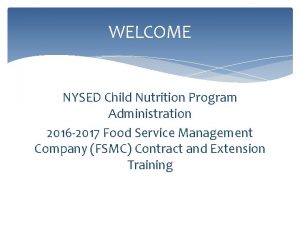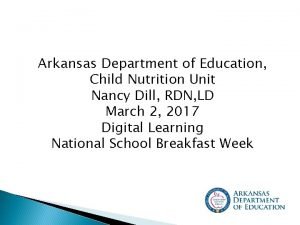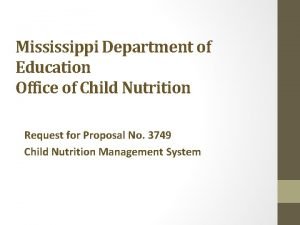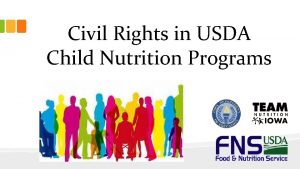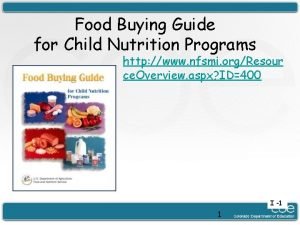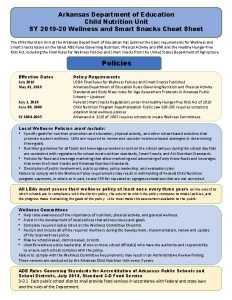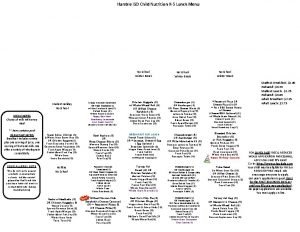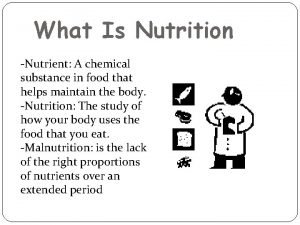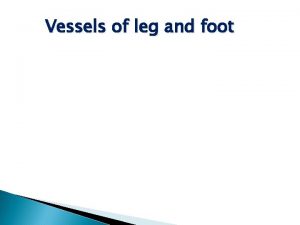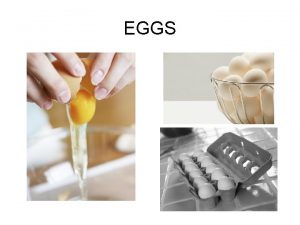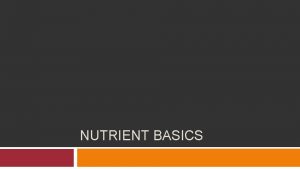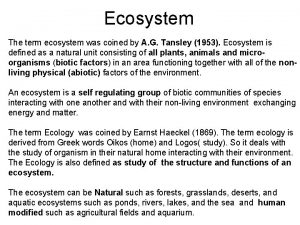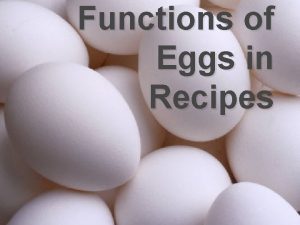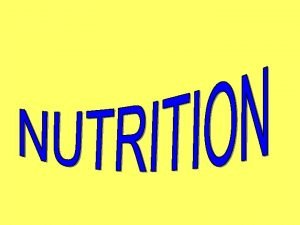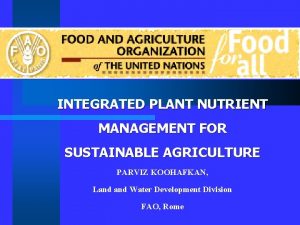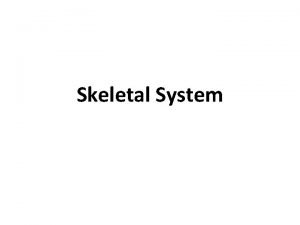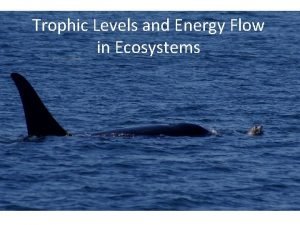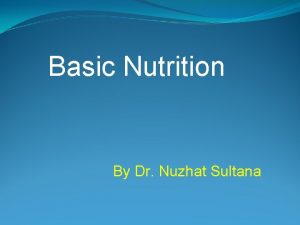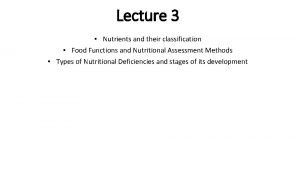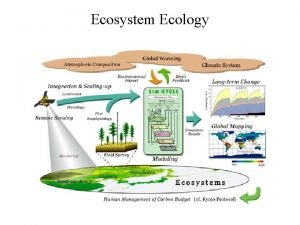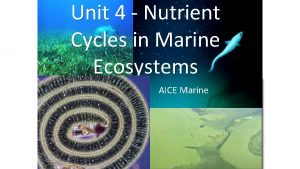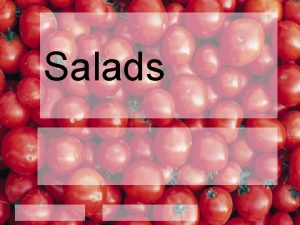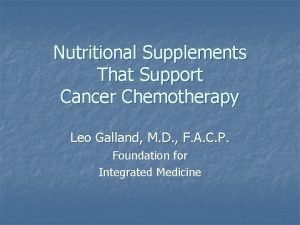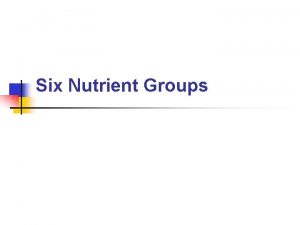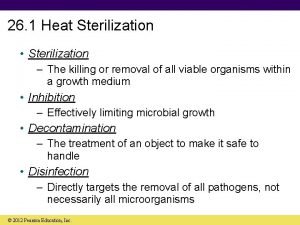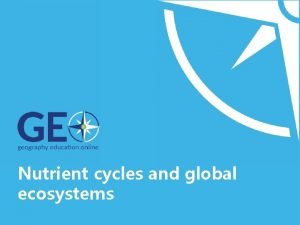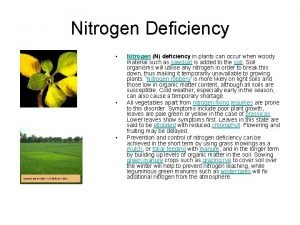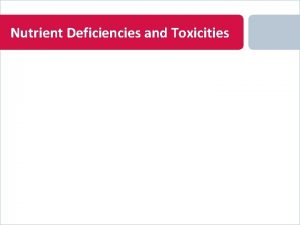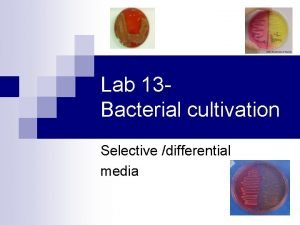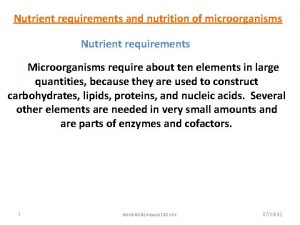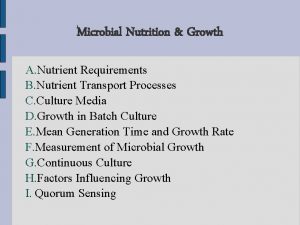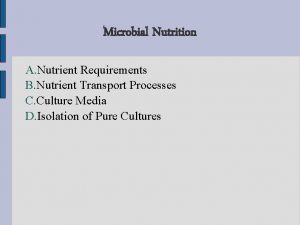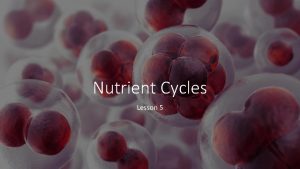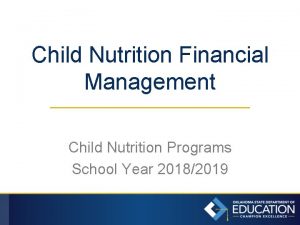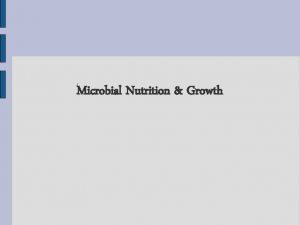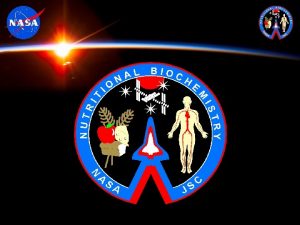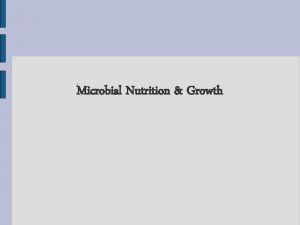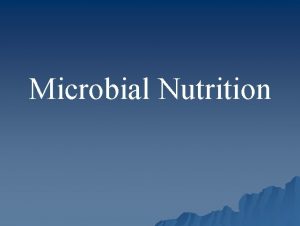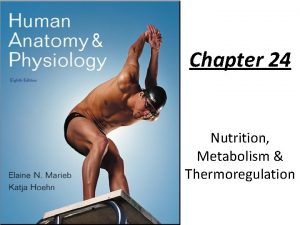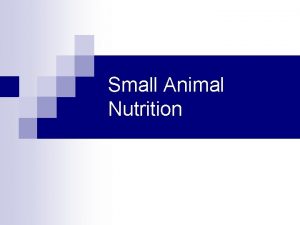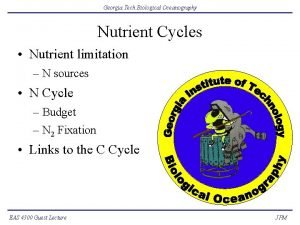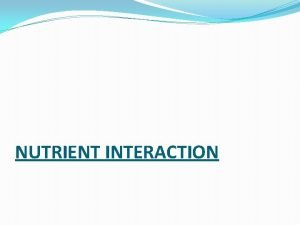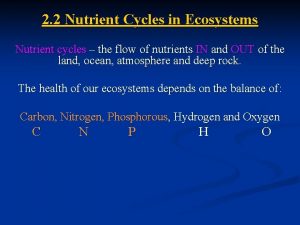NUTRITION NUTRITION The nutrient requirements of the child
























































- Slides: 56

NUTRITION

NUTRITION The nutrient requirements of the child are influenced by; l Body composition, the rate of growth l Composition of new growth l Vary with the child’s age l Important during early postnatal life l

NUTRITION l Growth rate; higher in early infancy l Body composition ; e. g. brain accounts for 10% of body weight. (a: 2%) needs 44% of total energy (a: 19%) l Composition of new growth : e. g. Fat accounts for about 40% of weight gain between birth and 4 months but only 3% between ages 24 and 36 months. (pr, 11% and 21%)

NUTRITION l Because of the high nutrient requirements for growth and body composition, the young infant is especially vulnerable to undernutrition. l Slowed physical growth rate; early and prominent sign of undernutrition in the young infant.

major determinants of energy: (6 -12 months) l Basal metabolism l Metabolic response to food l Physical activity l Growth (5% after 1 year) 50% 5% 25% 12%

NUTRITION: Energy need l The first year; 80 -120 kcal/kg/day, decreases 10 kcal/kg/day every three years. l In infants; 9 -15% from proteins 45 -55% from carbohydrates 35 -45% from fats l In older children; 10 -15% prt 55 -60% ch 30 % fat

Proteins : 4 cal/1 gr prt l Aminoacids+ammonium compounds l 24 aa ; 9 are essential for infants (cannot be synthesized)= treonin, valine, leusine, isoleusine, lysine, tryptophan, phenylalanine, methionine, histidin. l arginine, cystine, and taurine= essential for LBW infants (taurine; improve fat absorbtion in preterm infants)

Proteins : 4 cal/1 gr prt l Dietary protein is hydrolyzed by in the stomach PEPSIN l Pancreatic TRYPSIN digestion in the lumen of small intestine l PEPTIDASE digestion by pancreatic and intestinal peptidases l Nitrogen is absorbed from the gut lumen as A. A. >v. porta>liver>tissues

Proteins : 4 cal/1 gr prt l Liver plays a central role in aa metabolism l Excess aas are degraded in the liver except for the branched chain aas which pass in to the systemic circulation and are taken up primarly by muscle. After removed of the amino group, the ketoacids are either utilized directly for energy or converted to carbohydrate and fat. Nitrogen is excreated primarly via the kidney as UREA.

Proteins : 4 cal/1 gr prt l AA in tissues; albumin hemoglobine hormones All the body’s protein plays a role ; - in body structure - function Because there are no true stores of body protein, a regular dietary intake is neces sary.

LIPIDS; fats are the main dietary energy source for infants. l Over 98% of these fats are in the form of TRIGLYCERIDEs (3 fatty acids + gliserol) l 2% free fatty acids, cholesterol, mono- di glicerides, phospholipids. l Natural fats contain saturated or unsaturated long chain fatty acids with 4 -24 carbon atoms.

FATS are required; l For the absorbtion of fat soluble vitamins l For myelination of CNS, l Provides essential fatty acids (EFA) necessary, l For brain development, l For phospholipids in cell membranes, l For synthesis of prostoglandins and leukotrienes

LIPIDS l EFA’s are polyunsaturated fatty acids derived from; l LINOLEIC ACID W 6 ; 1, 7% of total cal. l LINOLENIC ACID W 3 ; 0, 5% of total cal. l Arachidonic acid can be obtained from linoleic acid and primarily present in membrane phopholipids ( prostoglan_ dines and leukotriens ^^metabolites of arachidonic acid^^ contain W 6)

LIPIDS l Linolenic acid is a W 3 acid. l Controls synthesis of arachidonic acid, and effective on nerve conduction. l Important derivatives of linolenic acid are; l Eicosapentaenoic acid l Decosahexaenoic acid = found in human milk and brain lipid

LIPIDS l Deficiency of EFA(W 6) = growth failure, erythematous skin lesions, decreased capillary resistance, increased fragility of erythrocytes, thrombocytopenia, poor wound healing, increased susceptibility to infection

LIPIDS l Deficiency of EFA (W 3); dermatitis, neurologic abnormalities (blurred vision, peripheral neuropathy, weakness)

LIPIDS l Digestion; l oral lipase l In the lumen of the gut ; pancreatic lipase; triglycerides hydrolises to monoglycerides, FFA, Gliserol. - Bile salts

LIPIDS l Pancreatic lipase and bile salt levels are low in early postnatal life. l Bile salts have a major role in emulsification of FA allowing their passage through the unstirred water layer to the surface of the mucosal cell.

LIPIDS l After passage into the enterocyte LONG CHAIN (≥ C 12) FAs and monoglycerides are reesterified to monoglycerides to triglycerides and are packaged with phospholipids, cholesterol and protein into chylomicrons which are transported in the lymphatics to the systemic circulation.

LIPIDS l At the capillary endothelial surface in adipose and muscle tissue, LPL hydrolyzes triglycerides from chylomicrons releasing FFA and glycerol which are taken up by the adjacent cells. LPL also hydrolyzes triglycerides synthesized in the liver and transported to peripheral tissues as very low density lipoproteins. (VLDL)

LIPIDS of FA takes place in mitochondria of muscle and liver. CARNITINE is necessary for oxidation of FAs. (carnitine is synthesized in human liver & kidney) l In the liver substantial quantities of FA s are converted to ketone bodies==> released in to the circulation and provide an important source of fuel for the brain in the young infant l ß-oxidation

LIPIDS l MCT are much more readily absorbed than LCT and are then transported directly to the liver via portal circulation. They are rapidly metabolized in the liver, don’t require carnitine to enter mitochondria. Useful in luminal phase defects (cirrhosis), absorbtive defects (short bowel syndrome, chronic inflammatory bowel disease)

LIPIDS; energy density of l 1 gr SCFAS 5, 3 kcal l 1 gr MCFAS 8, 3 kcal l 1 gr LCFAS 9 kcal

CARBOHYDRATES l The energy density of CH is 4 kcal/gram stored as glycogen in liver and muscle. l Monosaccaride: glu, gal, fru l Disaccaride: lac, suc, mal in diet. l Polysaccaride: starch l Starch (amilase) ____ > disaccarides and oligosaccarides = > hydrolized into glu, gal, fru.

Carbohydrate digestion l Oral and pancreatic amilase (starch) l Disaccaridase (disaccarides) at microvilli l Absorb from the intestinal mucosal cells.

CARBOHYRATES l Maltose: glu + glu l Lactose: glu + gal l Sucrose: glu + fru ; at the base of the villi. l Glu and gal are absorbed actively with Na. l Glu is the principal fuel for the brain and necessary energy source for certain other tissues including red and white blood cells.

MAJOR MINERALS l CALCIUM: More than 99% in the skeleton. l 55% is ionized in blood plays a role in neuronal exitability, contraction of muscles. # regulation of enzyme activities # coagulation formation # Ag-Ab interaction.

MAJOR MINERALS l Control of Ca absorbtion = 1, 25 DHC, PTH, Calsitonin l Plasma level : 9 -11 mg % l Dietary sources: milk and products, green leafy vegetables, fortified cereals egg yolk.

MAJOR MINERALS PHOSPHORUS: More than 85% of body P in bone. P is a component of many organic compounds that have a vital role in metabolism including ATP & 2, 3 DPG. The other compounds containing P include cell membrane phospholipids and nucleotides. ~ 80% of dietary phophorus is absorbed; the kidney is responsible for homeostatic control. PTH decreases tubular reabsorbtion of P. Plasma levels 3 -4, 5 mg/dl (4 -7 mg/dl in children) l Sources: milk, cheese, egg yolk, meat, cereal, green leafy vegetables. l

MAJOR MINERALS l MAGNESIUM: 50% is in bone. 25% is in muscles. Intracelular. Activates many enzymes => P hydrolyzing and transferring enzymes involved in energy metabolism. Plays major role in nucleic acid metabolism. Plays a role in neuromusculer exitability. Plasma level ; 1, 5 -2 m. Eq/L. l Sources: soya been, cereal, green leafy vegetables.

MAJOR MINERALS l SODIUM : 125 -145 m. Eq/L. l Extracellular mineral l Osmotic and acid-base regulation l Absorbed from intestine l Excreated via, urine sweet and stool

MAJOR MINERALS l POTASSIUM: 3, 5 -4, 5 m. Eq/L. l Intracelular mineral. l Muscle contraction. l In acidosis intracelular K+ is changed for H+=> K+ is shifted into the extracel- lular fluid and is lost in urine=> total body K is depleted.

MAJOR MINERALS l CHLORIDE: Extracellular mineral. l Osmotic and acid-base regulation. Active Cl transport in ascending loop of Henle in necessary for passive reabsorbtion of Na+.

TRACE ELEMENTS : l Iron, iodine, zinc, copper, selenium, manganese, molibdenium, chromium, cobalt, fluoride. l Dietary sources: Human milk, meat, shellfish, nut, cereals. l The breastfed infants doesn’t require other sources of trace elements including iron for the first 4 -6 months. l Infants feed cow’s milk are at risk for deficiencies of iron and copper.

MAJOR MINERALS l Iron: component of Hb, myoglobin, cytocroms; for oxygen transport. l Zinc: component of many enzymes in nucleic acid metabolism, protein synthesis. l Copper: component of several oxidative enzymes. l Selenium: essential component of glutathione peroxidase which catalyzes the reduction of hydrogenperoxide to water.

VITAMINS l FAT SOLUBLE : A, D, E, K. l WATER SOLUBLE: B 1, B 6, B 12, folic acid, C vit, niacin, pantothenic acid, biotin, carnitine.

FAT SOLUBLE VITAMINS l Deficiency in those vitamins develop more slowly because the body accumulates stores of fat soluble vitamins. Excessive intakes carry a considerable potential for toxicity. l Vit A : A critical role in photochemical basis of vision, modifies differentiation and proliferation of epithelial cells. (resp syt). Necessary for glycoprotein synthesis and for integrity of the immune system.

FAT SOLUBLE VITAMINS Precursor, ßcarotene => 2 mol A vit l Serum level : 20 -50 microgr/dl l Suggested intake/ day: 200 U/ 100 kcal l Active Vit A retinol retinal retinoic acid retinil ester

FAT SOLUBLE VITAMINS l Deficiency : Night blindness, xerosis (dryness of cornea and conjuctiva), xerophtalmia (extreme dryness of conjunctiva), Bitot spots, ulceration and perforation of cornea, follicular hyperkeratosis, pruritis, growth retardation, anemia, hepatosplenomegaly, susceptibility to infection.

FAT SOLUBLE VITAMINS l Toxicity (20, 000 IU/day) vomiting, increased intracranial pressure, irritability, headache, emotional lability, arthralgia, abdominal pain. l Diatary sources: egg, liver, meat, fish oil, corn.

FAT SOLUBLE VITAMINS l Vit D: regulates Ca, P metabolism. Stimulates the intestinal absorbtion of Ca, P. Renal absorbtion of filtered Ca. Mobilization of Ca and P from bone. l DHC in the skin--> cholecalciferol (D 3) (UV 296 -310 μ) l Ergosterol ---> ergocalciferol (D 2) (radiation)

FAT SOLUBLE VITAMINS l Absorbed Vit D (in chylomicrons)--> liver (undergo 25 -OH)= calcidiol l Kidney (1 -OH) = active vit D 1. 25 dihydroxycholecalciferol, calsitirol l Suggested intake /day = 400 IU ( 800 IU for preterms) l 30 min/wk total body l 2 hr/wk head sun exposure

FAT SOLUBLE VITAMINS l Deficiency: osteomalacia (adults) , rickets (children) l Toxicity: hypercalcemia, vomiting, constipation, nephrocalsinosis. l Dietary source: vit D fortified milk, formulas, egg yolk, fish.

FAT SOLUBLE VITAMINS l VITAMIN E: stops oxidant reactions (antioxidant) cell membrane stabilization, modulate genetic expression, platelet aggregation l Deficiency: hemolytic anemia, neurologic disoreder, abnormalities in eye movements, weakness, degeneration of retina. l Toxicity: necrotising enterocolitis.

FAT SOLUBLE VITAMINS l VITAMIN K: K 1 is obtained from leafy vegetables, soybean oil, seeds, cow milk. l K 2 = 60% of the activity of K 1 is synthesized by intestinal bacteria. l Necessary for the maintenance of normal plasma level of coagulation factors II, VII, IX, X l Necessary for maintenance of normal levels of anticoagulation protein c.

FAT SOLUBLE VITAMINS Vit K deficiency occurs in newborns especially those who are breast fed and who do not receive vit K prophylaxis at delivery = hemorrhagic disease of newborn. l Later vit K deficiancy occurs = fat malabsorbtion syndromes, use of nonab- sorbed antibiotics, use of anticoagulant drugs (warpharine) l Hemorrhage into the skin , GIS, GUS, gingiva, lungs, joints, CNS l Toxicity; vomiting, hemolytic anemia, hyperbilirubinemia. l

WATER SOLUBLE VITAMINS l Danger of toxicity is not great because excesses of these vitamins can be excreated in the urine. l Deficiencies develop more quickly because of limited stores. l Vit B : B 1(Thiamin) B 2 (Riboflavin), Niacin, B 6 (Pridoxine), Pantothenic acid, Folic acid, B 12 (Cobalamin), Biotin l Coenzyme in carbohydrate, protein and fat metabolism

WATER SOLUBLE VITAMINS l B 12 - Folic acid ; formation of erythro- cytes l B 1; whole grain, cereals. Def; infantile beri (cardiac, aphonic, pseudomeningitic) (seen in infants breastfed by mothers with history alcoholism or poor diet, complication of TPN, PEM or prematurity

WATER SOLUBLE VITAMINS l l l B 2 : Meat, wheat, leafy vegetables. Def: chelitis, angular stomatitis, glossitis, B 6 All foods Def: irritability, seizure, GI disturbance, anemia, glossitis, cheliosis, (prematurity, drug {INH}) NİACİN: meat, fish, wheat. Def: pellagra, (weakness, dermatitis, diarrhea, dementia) (prematurity, maize- millet diets – high leucine low triptophan)

WATER SOLUBLE VITAMINS l Pantothenic acid : ubiquitous l Def: weakness, GI disturbance, burning feet l Biotin : yeast, liver, kidneys, nuts, egg yolks l Def: dermatitis, alopecia, irritability, lethargy. (supressed intestinal flora and impaired intestinal absorbtion)

WATER SOLUBLE VITAMINS l Folic acid : leafy vegetables, fruits, whole grains, orange juice, beans, nuts. l Def: megaloblastic anemia, neutropenia, thrombocytopenia, growth retardation, delayed maturation of CNS in infants, glossitis, jaundice, mild splenomegaly, neural tube defects. (prematurity, fed with cow’s milk, goat’s milk, PEM, malabsorbtion syndromes, cirrhosis, infections.

WATER SOLUBLE VITAMINS l B 12 : Eggs, liver, meat. l Def: megaloblastic anemia, neurologic degeneration (congenital malabsorbtion syndromes, strict vegeterian diet, breastfed infants of mother latent pernicious anemia) l Vitamin C: Strong reducing agent. l Collagen synthesis l Cholesterol= bile acids, steroid hormones

WATER SOLUBLE VITAMINS Leukocyte function Interferon production Carnitine synthesis Fresh fruits, vegetables Def: anorexia, irritability, apathy, pallor, fever, tachycardia, failure to thrive, increased susceptability to infections, hemorrhagen under skin, long bone tenderness, costacondral beading l (prematurity, lack of fresh fruit and vegetables, maternal megadose during pregnancy= def in infants) l l l

WATER SOLUBLE VITAMINS l CARNITINE: Transfer of long chain FA from cytosol to mitochondria ( necessary for β- oxidation) l Def: increased serum TGs and FFA, decreased ketones, hypoglycemia, progresive muscle weakness or cardiomyopathy (dialysis, inheredited deficits of carnitine synthesis, organic acidemia, valproic acid. )


THANKS
 Transport media for salmonella
Transport media for salmonella Foods used in nutrition activities should be nutrient-dense
Foods used in nutrition activities should be nutrient-dense Hcnp
Hcnp Civil rights in child nutrition programs
Civil rights in child nutrition programs Nysed child nutrition
Nysed child nutrition Civil rights training child nutrition programs
Civil rights training child nutrition programs Humble isd elementary menu
Humble isd elementary menu Child nutrition unit arkansas
Child nutrition unit arkansas Mississippi office of child nutrition
Mississippi office of child nutrition Civil rights in child nutrition programs
Civil rights in child nutrition programs Meals per labor hour formula
Meals per labor hour formula Food buying guide for child nutrition programs
Food buying guide for child nutrition programs Ncdpi child nutrition
Ncdpi child nutrition Product formulation statement
Product formulation statement Arkansas child nutrition unit
Arkansas child nutrition unit Humble isd elementary menu
Humble isd elementary menu Left child right sibling tree
Left child right sibling tree Nutrition body
Nutrition body Dorsalis pedis artery
Dorsalis pedis artery Brays nutrient mobility concept
Brays nutrient mobility concept Site:slidetodoc.com
Site:slidetodoc.com Egg cooking style
Egg cooking style Nutrient interactions
Nutrient interactions Nutrient basics
Nutrient basics Which ecosystem is this nutrient cycle from?
Which ecosystem is this nutrient cycle from? Functions of eggs
Functions of eggs Nutrient substance
Nutrient substance Integrated plant nutrient system
Integrated plant nutrient system Parts of a long bone
Parts of a long bone Nutrient chain foldable
Nutrient chain foldable How does deforestation affect the nutrient cycle
How does deforestation affect the nutrient cycle Regents biology food chains and energy in ecosystems
Regents biology food chains and energy in ecosystems Brays nutrient mobility concept
Brays nutrient mobility concept Nutrition defination
Nutrition defination Functions of nutrients
Functions of nutrients Nutrient cycle in the serengeti
Nutrient cycle in the serengeti Nutrient cycles in marine ecosystems
Nutrient cycles in marine ecosystems 4 types of salad
4 types of salad Tamoxifen nutrient depletion
Tamoxifen nutrient depletion Journey 2050 student handout 2 word search
Journey 2050 student handout 2 word search Six nutrient groups
Six nutrient groups Nutrient agar plate
Nutrient agar plate Biogeochemical cycles apes
Biogeochemical cycles apes Gersmehl model deciduous woodland
Gersmehl model deciduous woodland What nutrient cushions vital organs
What nutrient cushions vital organs Whats a nutrient cycle
Whats a nutrient cycle Nutrient deficiency in tomatoes
Nutrient deficiency in tomatoes Chlorsis
Chlorsis How does a plant resist disease and pests journey 2050
How does a plant resist disease and pests journey 2050 Non fastidious definition microbiology
Non fastidious definition microbiology Hệ hô hấp
Hệ hô hấp Lp html
Lp html Thế nào là số nguyên tố
Thế nào là số nguyên tố Phối cảnh
Phối cảnh đặc điểm cơ thể của người tối cổ
đặc điểm cơ thể của người tối cổ Các châu lục và đại dương trên thế giới
Các châu lục và đại dương trên thế giới Chụp tư thế worms-breton
Chụp tư thế worms-breton




